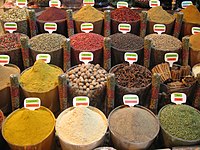
Photo from wikipedia
Bixa orellana L. is endemic to the tropical zone of the Americas. In a previous study, our research group detected antiinflammatory properties in the leaves of three accessions of Bixa… Click to show full abstract
Bixa orellana L. is endemic to the tropical zone of the Americas. In a previous study, our research group detected antiinflammatory properties in the leaves of three accessions of Bixa orellana L. in the Maya area. Our next objective was to perform a morphological analysis of the seeds and determine their chemical and nutrient composition, and the results are described herein. The morphological characterization was based on 8 quantitative and 14 qualitative characters, and some important similarities and differences were found in the length and shape of leaves and seeds, ramifications, dehiscence of fruits, and number of seeds per fruit. Regarding the chemical composition, accession 3 had the highest values for bixin (40.83 ± 1.27 mg/g), phenolic compounds (9.65 ± 0.18 mg GAE /g milligrams gallic acid equivalents per gram of seeds, carbohydrates (43.3 ± 0.24%), and functional dietary fiber, while accession 1 had the highest values for proteins (13.83 ± 0.04%) and ash (4.53 ± 0.2%). The plants of accession 3 whose seeds had the highest phenolic compounds and bixin content also had the leaves with the greatest anti-inflammatory effect. Thus, the plants of accession 3 are an ideal candidate for the propagation and integral use of their biological material. The next challenges are the study of the annatto plant’s reproduction and the chemical composition of its fruits.
Journal Title: Pakistan Journal of Botany
Year Published: 2021
Link to full text (if available)
Share on Social Media: Sign Up to like & get
recommendations!